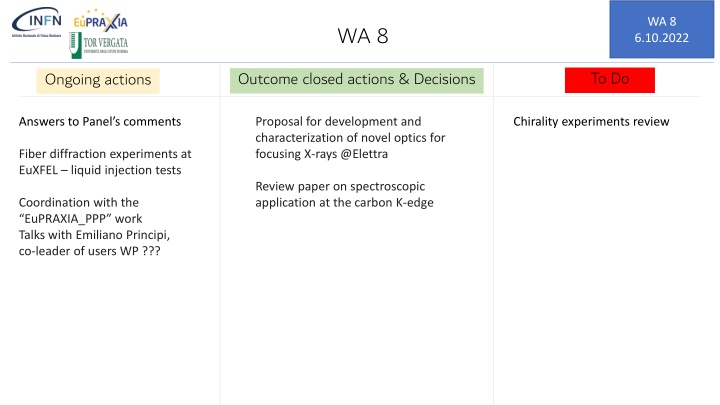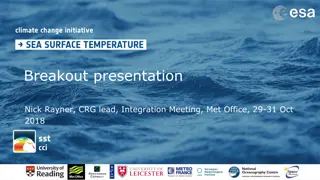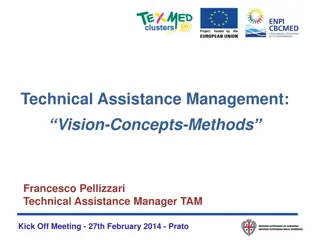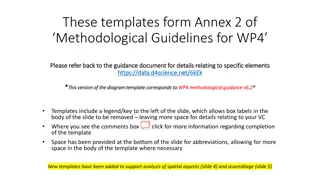
Novel Optics Development and X-ray Focusing Advancements
Explore the development and characterization of novel optics for X-ray focusing, review experiments on chirality and fiber diffraction, and coordinate with research committees for spectroscopic applications and user engagement in photon beamlines.
Download Presentation

Please find below an Image/Link to download the presentation.
The content on the website is provided AS IS for your information and personal use only. It may not be sold, licensed, or shared on other websites without obtaining consent from the author. If you encounter any issues during the download, it is possible that the publisher has removed the file from their server.
You are allowed to download the files provided on this website for personal or commercial use, subject to the condition that they are used lawfully. All files are the property of their respective owners.
The content on the website is provided AS IS for your information and personal use only. It may not be sold, licensed, or shared on other websites without obtaining consent from the author.
E N D
Presentation Transcript
WA 8 6.10.2022 WA 8 To Do Outcome closed actions & Decisions Ongoing actions Answers to Panel s comments Proposal for development and characterization of novel optics for focusing X-rays @Elettra Chirality experiments review Fiber diffraction experiments at EuXFEL liquid injection tests Review paper on spectroscopic application at the carbon K-edge Coordination with the EuPRAXIA_PPP work Talks with Emiliano Principi, co-leader of users WP ???
WA 8 6.10.2022 WA 8 General comments from the panel: The presentation at the meeting includes several exciting prospects in terms of scientific ideas. The main beamline AQUA aims to reach the water window ( 4 nm) with a flux of in the order to 10^11 photons/pulse. This gives an excellent opportunity for experimental programs from imaging to various spectroscopy techniques in the water window. The second beamline, ARIA, aims for the VUV-wavelength range (50 to 180 nm). Both electron and photon beamlines will be set-up side-by-side, space in the hall seems to be available. Tentative answers We are encouraged by the panels comment on the scientific case. We ll pursue the experimental plan in the water window and push that in the VUV range.
WA 8 6.10.2022 Review committee: AQUA As for AQUA, it is not clear what the radiation bandwidth is, as it is not clear how photons will be delivered to the sample (e.g., after a monochromator?). The scientific case of AQUA includes coherent diffractive imaging (CDI), X-ray spectroscopy, Raman spectroscopy, and molecular fragmentation. It is not clear whether X-ray spectroscopy includes both absorption and emission or only one of these. Also, the Raman spectroscopy plan is not explained: is this electronic Raman? Molecular fragmentation is an interesting topic, but it was not clear how it would be carried out. Are these photo-emission spectroscopy experiments (they seem more relevant for ARIA)? No liquid phase experiments are mentioned, but the presentation of test experiments at Elettra appears at the end of the presentation. This is an important development. Finally, the use of MCPs is a sound choice and their development is welcome. Tentative answers Coordination with WA6 about overall and single-shot bandwidth parameters Discussion about beam monochromatization: Depends on photon beam parameters > a plasma feeded FEL with large jitter + monochromator would end up in no photons on the samples in most of the shots. Should we still consider the linac-feeded option? Both XAS and XES can be in principle performed. Details on this and on Raman spectroscopy will be provided Molecular fragmentation measurements can also be performed @AQUA Kastirke et al. O2photoelectron diffraction imaging at SQS/EuXFEL (670 eV) Also, photoemission spectroscopy experiments are ideal for the ARIA beamline wavelength range Liquid jet: next slide
WA 8 6.10.2022 Liquid jets Details about liquid injection -> Key for water-window imaging, among the others 3D printed GDVN, Thin sheets under development in pilot experiments @ Elettra (courtesy of Marcello Coreno, from Gabriele Bonano s thesis) 1. Gas-dynamic nozzle Air channel: 50 m Liquid channel: 20 m 2. HPLC and flow controller 3. Leaf shaped primary sheet 4. Adjustable dimensions
WA 8 6.10.2022 Review committee: ARIA The ARIA FEL would fill an important gap as there are hardly any vacuum ultraviolet (VUV) FEL at present (except in Dalian, China), which operates at a single energy of 24 eV. The major advantage over HHG sources is photon flux, though here again, it is not clear how the beam will be delivered to the sample. More or less the same scientific topics. WHAT DOES THAT MEAN? In none of the two cases was the option of chirality studies mentioned. These lend themselves to both photon (absorption) and electron (photoemission) spectroscopy. Tentative answers Beam delivered on samples: no monochromator (Seeded FEL), but focusing optics There is an overlap of AQUA and ARIA scientific cases in terms of techniques, but we ll clarify the issue and point out the priorities for both beamlines Chirality experiments will be detailed
WA 8 6.10.2022 Review committee: Beamlines The photon beamlines presentation was fairly detailed in terms of mirrors, focusing optics, spectrometers, monochromators, various diagnostics, timing measurements, and other detectors. The RC was pleased to hear about the progress made in completing the photon beam diagnostic package for both beamlines, AQUA and ARIA. The RC suggests that in a next step, all diagnostic items be addressed in more detail: from design, construction and prototyping, to realization. One should start with the key components and with those requiring a long development time. Measurements of the number of photons per pulse, of spectrum, of transverse pulse shape, including the wavefront are essential for start-up FEL operation. A specific effort needs to go into the design and production of all mirrors and focusing elements (especially the KB-optics). Another important point is to understand how all the diagnostics components presented could fit into the short beamline space available. The RC wants to point out that some important parameters, such as the monochromator transmission efficiency and general stability issues, have not yet been specified. The RC would like to hear about detailed specifications of key diagnostic elements in the next meetings. Tentative answers We are including the synchrotron beamline group in the WP, some time is necessary for discussion and updating We are working on a technical document (tender-like detail) collecting the information, specifications and drawings First focused elements are the mirrors and the spectrometer We are simultaneously working on beam transport simulations and defining each element transmission (first estimation ready for the RC in December)
WA 8 6.10.2022 WA 8 WP4 Upcoming milestones Potential risks General Status 1. 31/12/22 Preliminary optical simulation of the beamlines 1. Changes in beamlines layout Business as usual but some issues might become critical It s all ok! 2. 31/12/22 Evaluation of Scientific Case for other wavelengths (ARIA) 2. Commitment of the user community




